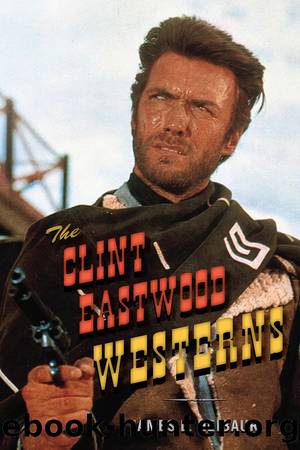The Clint Eastwood Westerns by James L. Neibaur

Author:James L. Neibaur [Neibaur, James L.]
Language: eng
Format: epub
Publisher: Rowman & Littlefield Publishers
Published: 2014-01-15T00:00:00+00:00
Chapter 10
Between the Westerns (1968â1971)
In our discussion of Clint Eastwoodâs western films, it is important to also acknowledge the non-western movies he made, especially since they often inspire each other.
This is, however, not the case with Where Eagles Dare (1969), which has been mentioned earlier. Writer Alistair MacLean (The Guns of Navarone) completed the script for Where Eagles Dare in six weeks, basing it on his novel. Eastwood starred in support of Richard Burton, the two of them calling the film Where Doubles Dare due to all the work their stand-ins and stuntmen had to perform. A fair film, it was a box office success, but it is most notable now for its early use of front projection effect, a visual effect that combines foreground action with background footage already filmed.
Eastwood felt there was potential in Kellyâs Heroes (1970), about a group of World War II soldiers who go AWOL to rob a bank behind enemy lines. Eastwood recalled that director Brian Hutton had put together a much better movie than what was eventually released after the studio tampered with the completed film. The actor believed the subsequent cuts took away a great deal of depth from the characters. Eastwood was disappointed in Kellyâs Heroes. He felt the filmâs initial potential had not been reached, and he even offered to do more work on it himself. The cast in this film is so vast none of them, including Eastwood, are given enough attention to develop a character. Kellyâs Heroes is entertaining, but not outstanding.
However, being an actor dropped into a big studio production does not allow the level of creative input where his past films might inspire or help to interpret his work.
Play Misty for Me (1971) was Eastwoodâs first feature-length directorial effort, and it became one of his most successful films from both a critical and box office perspective. He had discussed this project with Malpaso co-founder Irving Leonard, but Leonardâs death in 1969 caused the project to be set aside until Eastwood had the opportunity to produce it. Eastwood told Marc Eliot for his book American Rebel: The Life of Clint Eastwood:
After seventeen years of bouncing my head against the wall, hanging around sets, maybe influencing certain camera set-ups with my own opinions, watching actors go through all kinds of hell without any help, and working with both good directors and bad ones, Iâm at the point where Iâm ready to make my own pictures. I stored away all the mistakes I made and saved up all the good things I learned, and now I know enough to control my own projects and get what I want out of actors.
In one of the first films to deal with stalking, Clint Eastwood plays a radio DJ who frequently receives calls from a woman (Jessica Walter) requesting the pop standard âMisty.â He eventually meets the woman, they have sex, and she thereafter stalks him while exhibiting increasingly greater personality disorders. Things get especially unsettling once the DJ rekindles a relationship with an old girlfriend (Donna Mills).
Download
This site does not store any files on its server. We only index and link to content provided by other sites. Please contact the content providers to delete copyright contents if any and email us, we'll remove relevant links or contents immediately.
| Direction & Production | Genres |
| Guides & Reviews | History & Criticism |
| Reference | Screenwriting |
| Shows |
Robin by Dave Itzkoff(2386)
Head of Drama by Sydney Newman(2257)
I'm Judging You by Luvvie Ajayi(2151)
The Paranormal 13 (13 free books featuring witches, vampires, werewolves, mermaids, psychics, Loki, time travel and more!) by unknow(2052)
Ten by Gretchen McNeil(1832)
Single State of Mind by Andi Dorfman(1762)
#MurderTrending by Gretchen McNeil(1615)
Key to the Sacred Pattern: The Untold Story of Rennes-le-Chateau by Henry Lincoln(1595)
Merv by Merv Griffin(1565)
Most Talkative by Andy Cohen(1547)
This Is Just My Face by Gabourey Sidibe(1438)
Notes from the Upside Down by Guy Adams(1414)
The Hunger Games: Official Illustrated Movie Companion by Egan Kate(1389)
Springfield Confidential by Mike Reiss(1365)
Jamie Oliver by Stafford Hildred(1357)
Binging with Babish by Andrew Rea(1330)
Clarkson--Look Who's Back by Gwen Russell(1307)
The TV Writer's Workbook: A Creative Approach To Television Scripts by Ellen Sandler(1300)
Blue Planet II by James Honeyborne & Mark Brownlow(1238)
